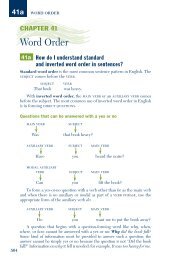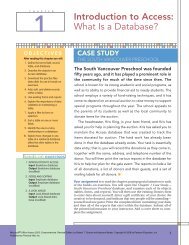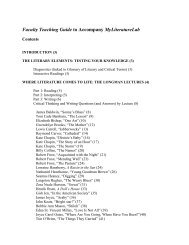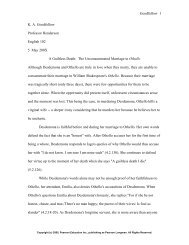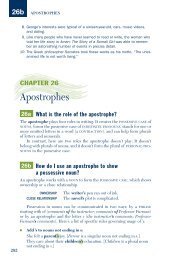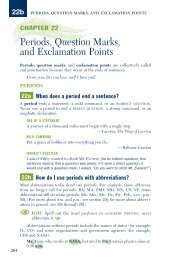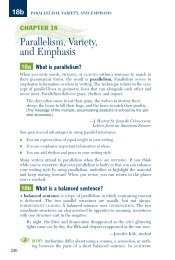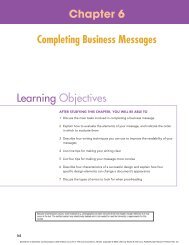chapter 3 - Pearson Learning Solutions
chapter 3 - Pearson Learning Solutions
chapter 3 - Pearson Learning Solutions
Create successful ePaper yourself
Turn your PDF publications into a flip-book with our unique Google optimized e-Paper software.
2009934667<br />
Physical characteristics<br />
Gustorics<br />
Proxemics<br />
Body Synchrony<br />
Aesthetics<br />
Kinesics<br />
Artifactics Olfactics<br />
Self<br />
Haptics<br />
Chapter 3 Nonverbal Communication 65<br />
Categories of Nonverbal Communication<br />
Nonverbal channels can be divided into many categories. Our discussion of these<br />
categories centers on kinesics, proxemics, paravocalics, chronemics, olfactics, aesthetics,<br />
and gustorics. 31 (See Figure 3.3.)<br />
Kinesics: Body Communication<br />
Kinesics is the study of communication through the body and its body movements.<br />
We communicate through the gestures we use, the way we walk and stand,<br />
the expressions on our faces and in our eyes, the manner in which we combine<br />
these variables to open or close channels, and what we look like. Specific areas<br />
studied in the area of kinesics are facsics; ocalics; gestics; haptics; posture, walk,<br />
and stance; artifactics; and physical characteristics.<br />
Facsics Facsics is the study of how the face communicates. “The 80 muscles of<br />
the face can create more than 7,000 expressions.” 32 These expressions range from<br />
communicating our internal states such as anger or fear, to carrying messages to<br />
others of whether we want to interrupt what they are saying or are interested and<br />
want them to continue to speak. The face sends information about our personality,<br />
interests, responsiveness, and emotional states. How we perceive another person is<br />
often based on that person’s facial expressions as we observe or interact with her.<br />
Research about the face and its messages has been conducted through FACS<br />
(Facial Action Coding System). Through this process, we have more data about<br />
the face than about any other area of nonverbal communication. 33 What has been<br />
determined is that facial expressions are highly complex. Facial expressions are<br />
Facsics<br />
Paravocalics<br />
Gestics<br />
Ocalics<br />
Chronemics<br />
FIGURE 3.3<br />
Categories of Nonverbal<br />
Communication<br />
Communicating: A Social and Career Focus, Tenth Edition, by Roy M. Berko, Andrew D. Wolvin, and Darlyn R. Wolvin. Published by Allyn & Bacon.<br />
Copyright © 2007 by <strong>Pearson</strong> Education, Inc.




